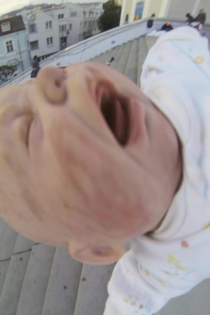
Norbert Pfaffenbichler
20212551.01
Norbert Pfaffenbichler
David Ionescu, Stefan Erber
A man rescues a boy and later tries to get him off his back but to little avail, so they end up drifting around a subterranean world, populated by grotesque masked figures. A hundred years after Chaplin filmed his first feature film, The Kid, Norbert Pfaffenbichler offers an experimental punk-style interpretation, which the filmmaker himself has defined as a dystopian slapstick film.
2551.01

A Messenger from the Shadows (Notes on Film 06 A/Monologue 01)
Norbert Pfaffenbichler
Lon Chaney
Thanks to his myriad film roles, Lon Chaney is known as “the man of a thousand faces,” and you could say that the early horror era never beheld a figure more intriguing. Yet because of his numerous transformations, his face never became as iconic as that of, say, Boris Karloff. Accompanied by a soundtrack from Bernhard Lang, this “re-imagination of shots” taken from Chaney´s forty-six surviving films offers a beguiling excursion into the history of film. The director reveals surprising associations, while highlighting the enduring magic of works which are now more or less forgotten.
A Messenger from the Shadows (Notes on Film 06 A/Monologue 01)

Santora
Norbert Pfaffenbichler, Jürgen Moritz
Santora is a metrically buildt cord of images based on the number 3 and the music of Fennesz. The video explores combinations of geometrical formes, building up corresponding sounds. Consious of their roots in historic avantgarde animation, but the same time drawing in structural cinema, the two filmmakers compose a "picture" which evolves from rectangels that appear on and disappear from the blank screen. White background, dark "windows", in which a figure seen from above passes through at various speeds. His diagonal passage, doubled and inverted, becomes another element of geometry and rhythm. The image, taken from an old film, evokes those of closed-circuit surveillance cameras by its impersonal repetitiveness. The sound obsessivily paces the variation in form on the screen.
Santora

A Masque of Madness (Notes on Film 06-B, Monologue 02)
Norbert Pfaffenbichler
Boris Karloff
In this experimental film, British actor Boris Karloff (1887-1969) embodies over 170 characters, experiencing a schizophrenic horror trip in which he faces versions of himself in different masks, at different ages, of different genders and races. As Karloff’s career spans over 50 years, from the silent era to modern-day cinema, A Masque of Madness allows us to witness the aesthetic and technical developments of the medium in one single film.
A Masque of Madness (Notes on Film 06-B, Monologue 02)

Intermezzo (Notes on Film 04)
Norbert Pfaffenbichler
A furious scene, virtuously reassembled, continuously intensifying, yet never moving. A brief excerpt from Charlie Chaplin’s 'The Floorwalker' (1916) serves as starting sequence for 'Intermezzo'. Chaplin, fleeing from a monstrous pursuer, down an up escalator, which at the time was the epitome of techno mechanical modernity; on the side, a mannequin as statuary counterpoint. Pfaffenbichler arranges the takes that he has pulled from the original film, enlarged, and in part, set as negatives or alienated in terms of color, according to a special verse scheme: ABABA BCBCB DCDCD, etc., whereby the selected excerpt continually advances to the action and the interlinking of the images becomes increasingly dodgy.
Intermezzo (Notes on Film 04)

36
Norbert Pfaffenbichler, Lotte Schreiber
Lotte Schreiber and Norbert Pfaffenbichler’s 36 is a rigidly mathematical and graphic composition based on the number in its title. All of this video´s elements, including its length, are variables of this figure. Three apparently independent fields of perception are linked by Stefan Németh´s synchronized soundtrack. In the left field, 36 vertical and horizontal white lines run through various patterns of movement according to a binary digital system (0 = vertical, 1 = horizontal). They eventually unite in six squares onto which amorphous animated miniatures are projected.
36

Mosaik mécanique
Norbert Pfaffenbichler
For the artist Fernand Leger (1881-1955), the promise of film as a new art form lay in its potential to exhibit the visual, to present an image rather than tell a story. This attribute characteristic of early cinema, a cinema of attractions (Tom Gunning), has been directly associated with avant-garde film in terms of visual exhibitionism as well as the construction of an audience that is both directly addressed and actively engaged.
Mosaik mécanique

